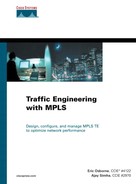Tunnel Identification Schemes
Chapter 9 discussed tunnel scalability and showed that you can build rather large networks with MPLS TE. Showing that the network can handle as many tunnels as you need it to is one thing. Showing how you actually support this setup is quite another.
One question that gets asked a lot is “How do I number my TE tunnels?” All TE tunnels on a router have a number—Tunnel0, Tunnel1, and so on.
The easiest method to assign a number to your tunnel is to assign each tunnel tailend a unique number. This number needs to be tracked in any provisioning systems you have, just like you track IP addresses or anything else. Then each router that terminates a tunnel on that particular tailend uses the assigned tunnel number to do so.
Assume that you're provisioning a full mesh between CRs (see Chapter 9, in the section “Sample Network for Case Studies”) and that you assign DenverCR1 the number 1. This means that when you build a TE tunnel from DenverCR2 to DenverCR1, it's named Tunnel1. When you build a TE tunnel from SanDiegoCR3 to DenverCR1, the tunnel on SanDiegoCR3 is also called Tunnel1. And so forth.
Even better, leave yourself some room to grow. Rather than assigning tunnels Tunnel1, Tunnel2, Tunnel3, and so on, do it in multiples of 10. DenverCR1 gets Tunnel10, DenverCR2 gets Tunnel20, and so on.
This method of tunnel number assignment is effective if you want to load-share between routers, where you expand upward past the multiple of 10. So if two TE tunnels exist from BostonCR7 to DenverCR1, call them Tunnel10 and Tunnel11.
Tunnel numbers can range from 0 to 65,535. Even if you allocate tunnel numbers in blocks of 10 (all tunnels to DenverCR1 are Tunnel10, all tunnels to DenverCR2 are Tunnel20, and so on), you still have room for more than 6500 routers in your numbering space! So that's plenty of room.
Another useful thing you can do is put a description on a tunnel.
The description command is not TE-specific; it is a property you can give to any interface. Example 10-18 shows the basic configuration.
Example 10-18. Configuring a Tunnel Description
interface Tunnel1
description Tunnel1 from GSR3 to GSR7
ip unnumbered Loopback0
no ip directed-broadcast
load-interval 30
tunnel destination 192.168.1.7
tunnel mode mpls traffic-eng
tunnel mpls traffic-eng autoroute announce
tunnel mpls traffic-eng path-option 10 dynamic
end
|
If you don't give a tunnel a description, the tunnel name that's carried in the RSVP messages is a concatenation of the headend router name and tunnel number, as shown in Example 10-19.
Example 10-19. Tunnel Name When No Description Is Configured
gsr6#show mpls traffic-eng tunnels role middle brief Signalling Summary: LSP Tunnels Process: running RSVP Process: running Forwarding: enabled TUNNEL NAME DESTINATION UP IF DOWN IF STATE/PROT gsr3_t1 192.168.1.7 PO1/0 PO1/1 up/up Displayed 0 (of 1) heads, 1 (of 1) midpoints, 0 (of 0) tails |
As the output in Example 10-19 reveals, this is Tunnel1 from gsr3. If you put a description on the tunnel interface, the output then looks like Example 10-20.
Example 10-20. Tunnel Name When a Description Is Configured
gsr6#show mpls traffic-eng tunnels role middle brief Signalling Summary: LSP Tunnels Process: running RSVP Process: running Forwarding: enabled TUNNEL NAME DESTINATION UP IF DOWN IF STATE/PROT Tunnel1 from GSR3 to GSR7 192.168.1.7 PO1/0 PO1/1 up/up Displayed 0 (of 1) heads, 1 (of 1) midpoints, 0 (of 0) tails |
You can also display tunnels by name or by a regular expression that matches a name, as shown in Example 10-21.
Example 10-21. show mpls traffic-eng tunnels role middle name-regexp Command Output Using a Regular Expression Displays the Tunnel Description
gsr6#show mpls traffic-eng tunnels role middle name-regexp GSR3 LSP Tunnel Tunnel1 from GSR3 to GSR7 is signalled, connection is up InLabel : POS1/0, 18 OutLabel : POS1/1, implicit-null RSVP Signalling Info: Src 192.168.1.3, Dst 192.168.1.7, Tun_Id 1, Tun_Instance 2 RSVP Path Info: My Address: 192.168.11.6 Explicit Route: 192.168.12.7 192.168.1.7 Record Route: NONE Tspec: ave rate=9 kbits, burst=1000 bytes, peak rate=9 kbits RSVP Resv Info: Record Route: NONE Fspec: ave rate=9 kbits, burst=1000 bytes, peak rate=Inf |
The regular expression is a standard Cisco regular expression—the same kind you'd use in BGP, for example. You can find more information on standard Cisco regular expressions by doing a general search at www.cisco.com for the document titled “Regular Expressions.”
